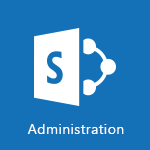SharePoint (Modern Sites) - The admin role Video
In this video, you will learn about the role of the administrator or admin for SharePoint and SharePoint Online.
The admin is defined by the global admin of the Office 365 Portal and their first task is to create the first site collection.
They can have one or multiple owners who are in charge of managing the top-level site and any future subsites.
Members can modify documents and guests can only view the site.
The admin also has a watcher role, managing storage quotas, user profiles, default language, and external sharing settings.
This knowledge will help you effectively manage SharePoint and SharePoint Online.
- 1:59
- 2724 views
-
SharePoint (Modern Sites) - Create a site collection
- 3:16
- Viewed 3134 times
-
SharePoint (Modern Sites) - Create a subsite
- 1:47
- Viewed 3252 times
-
Teams - Do I share with OneDrive, SharePoint, or TEAMS?
- 2:24
- Viewed 3330 times
-
OneDrive - What is OneDrive ?
- 01:14
- Viewed 1574 times
-
Word - Add a logo or other picture
- 3:17
- Viewed 2913 times
-
Power BI - General Introduction
- 2:54
- Viewed 4825 times
-
Outlook - Manage attachments
- 1:51
- Viewed 2804 times
-
Excel - Use slicers, timelines and PivotCharts to analyze your pivotetable data
- 3:38
- Viewed 2568 times
-
Activate the features of Teams Premium
- 3:48
- Viewed 13716 times
-
Conduct outstanding webinars with Teams Premium
- 2:37
- Viewed 5828 times
-
Create a subsite
- 1:47
- Viewed 3252 times
-
Create a site collection
- 3:16
- Viewed 3134 times
-
Viva Connections for your colleague
- 0:30
- Viewed 2751 times
-
Optimize meeting management with meeting templates
- 1:31
- Viewed 2684 times
-
Optimize Teams Premium settings in Administration
- 1:27
- Viewed 2607 times
-
Create a communication site
- 0:50
- Viewed 2534 times
-
What are virtual appointments in Teams Premium?
- 2:39
- Viewed 2473 times
-
Create a new page on a site
- 3:13
- Viewed 2467 times
-
Boost meetings with the advanced features of Teams Premium
- 1:18
- Viewed 2406 times
-
Delete and restaure a site or subsite
- 1:21
- Viewed 2373 times
-
Set your navigation on your site
- 3:16
- Viewed 2323 times
-
The manager role
- 2:41
- Viewed 2280 times
-
Deploy your Viva Connections
- 2:22
- Viewed 2220 times
-
Modify and set the authorisations for a list or a library
- 2:46
- Viewed 2171 times
-
Add an app
- 2:40
- Viewed 2163 times
-
Set up your navigation
- 0:53
- Viewed 2123 times
-
Define a parent site
- 1:04
- Viewed 1630 times
-
Access the admin center
- 0:52
- Viewed 1284 times
-
Configure the global Theme and logo
- 2:26
- Viewed 1254 times
-
Prevent comments on modern pages
- 1:15
- Viewed 1247 times
-
Create a SharePoint site
- 1:57
- Viewed 1164 times
-
Set the proper time zone
- 0:44
- Viewed 1139 times
-
Apply a Specific Policy to a User
- 1:22
- Viewed 1132 times
-
Create a permission group
- 2:11
- Viewed 1104 times
-
Disable site creation
- 0:52
- Viewed 1092 times
-
Define site storage limits
- 1:42
- Viewed 988 times
-
Disable the OneDrive sync button
- 0:49
- Viewed 949 times
-
Managing permissions on a SharePoint page
- 1:27
- Viewed 949 times
-
Choose expiration and permissions options for links opened to anyone
- 1:08
- Viewed 937 times
-
Delete a SharePoint site
- 1:12
- Viewed 927 times
-
Disable subsite creation
- 0:53
- Viewed 911 times
-
Modify membership to the sites of my organization
- 1:38
- Viewed 883 times
-
Managing permissions in a SharePoint folder
- 1:10
- Viewed 862 times
-
Managing permissions on a SharePoint file
- 1:12
- Viewed 828 times
-
Managing permissions of a document library
- 2:01
- Viewed 819 times
-
Managing permissions on a SharePoint List
- 1:42
- Viewed 814 times
-
SharePoint permission levels
- 2:16
- Viewed 800 times
-
Recover deleted items
- 01:09
- Viewed 361 times
-
Grant delegate access in Microsoft 365 administration
- 01:23
- Viewed 342 times
-
Add a third-party application
- 02:40
- Viewed 237 times
-
Mailbox Delegation Setup
- 01:59
- Viewed 207 times
-
Provide an overview of best security practices in Outlook
- 01:08
- Viewed 179 times
-
Introduction to PowerBI
- 00:60
- Viewed 169 times
-
Introduction to Microsoft Outlook
- 01:09
- Viewed 160 times
-
Introduction to Microsoft Insights
- 02:04
- Viewed 159 times
-
Introduction to Microsoft Viva
- 01:22
- Viewed 164 times
-
Introduction to Planner
- 00:56
- Viewed 173 times
-
Introduction to Microsoft Visio
- 02:07
- Viewed 160 times
-
Introduction to Microsoft Forms
- 00:52
- Viewed 166 times
-
Introducing to Microsoft Designer
- 00:28
- Viewed 226 times
-
Introduction to Sway
- 01:53
- Viewed 143 times
-
Introducing to Word
- 01:00
- Viewed 167 times
-
Introducing to SharePoint Premium
- 00:47
- Viewed 149 times
-
Create a call group
- 01:15
- Viewed 202 times
-
Use call delegation
- 01:07
- Viewed 130 times
-
Assign a delegate for your calls
- 01:08
- Viewed 200 times
-
Ring multiple devices simultaneously
- 01:36
- Viewed 138 times
-
Use the "Do Not Disturb" function for calls
- 01:28
- Viewed 128 times
-
Manage advanced call notifications
- 01:29
- Viewed 143 times
-
Configure audio settings for better sound quality
- 02:08
- Viewed 173 times
-
Block unwanted calls
- 01:24
- Viewed 140 times
-
Disable all call forwarding
- 01:09
- Viewed 144 times
-
Manage a call group in Teams
- 02:01
- Viewed 134 times
-
Update voicemail forwarding settings
- 01:21
- Viewed 132 times
-
Configure call forwarding to internal numbers
- 01:02
- Viewed 124 times
-
Set call forwarding to external numbers
- 01:03
- Viewed 149 times
-
Manage voicemail messages
- 01:55
- Viewed 189 times
-
Access voicemail via mobile and PC
- 02:03
- Viewed 205 times
-
Customize your voicemail greeting
- 02:17
- Viewed 127 times
-
Transfer calls with or without an announcement
- 01:38
- Viewed 122 times
-
Manage simultaneous calls
- 01:52
- Viewed 133 times
-
Support third-party apps during calls
- 01:53
- Viewed 162 times
-
Add participants quickly and securely
- 01:37
- Viewed 132 times
-
Configure call privacy and security settings
- 02:51
- Viewed 131 times
-
Manage calls on hold
- 01:20
- Viewed 140 times
-
Live transcription and generate summaries via AI
- 03:43
- Viewed 128 times
-
Use the interface to make and receive calls
- 01:21
- Viewed 133 times
-
Action Function
- 04:18
- Viewed 139 times
-
Search Function
- 03:42
- Viewed 189 times
-
Date and Time Function
- 02:53
- Viewed 172 times
-
Logical Function
- 03:14
- Viewed 257 times
-
Text Function
- 03:25
- Viewed 201 times
-
Basic Function
- 02:35
- Viewed 160 times
-
Categories of Functions in Power FX
- 01:51
- Viewed 189 times
-
Introduction to Power Fx
- 01:09
- Viewed 162 times
-
The New Calendar
- 03:14
- Viewed 283 times
-
Sections
- 02:34
- Viewed 172 times
-
Customizing Views
- 03:25
- Viewed 168 times
-
Introduction to the New Features of Microsoft Teams
- 00:47
- Viewed 273 times
-
Guide to Using the Microsoft Authenticator App
- 01:47
- Viewed 187 times
-
Turn on Multi-Factor Authentication in the Admin Section
- 02:07
- Viewed 147 times
-
Concept of Multi-Factor Authentication
- 01:51
- Viewed 174 times
-
Retrieve Data from a Web Page and Include it in Excel
- 04:35
- Viewed 393 times
-
Create a Desktop Flow with Power Automate from a Template
- 03:12
- Viewed 336 times
-
Understand the Specifics and Requirements of Desktop Flows
- 02:44
- Viewed 208 times
-
Dropbox: Create a SAS Exchange Between SharePoint and Another Storage Service
- 03:34
- Viewed 351 times
-
Excel: List Files from a Channel in an Excel Workbook with Power Automate
- 04:51
- Viewed 223 times
-
Excel: Link Excel Scripts and Power Automate Flows
- 03:22
- Viewed 229 times
-
SharePoint: Link Microsoft Forms and Lists in a Power Automate Flow
- 04:43
- Viewed 405 times
-
SharePoint: Automate File Movement to an Archive Library
- 05:20
- Viewed 199 times
-
Share Power Automate Flows
- 02:20
- Viewed 194 times
-
Manipulate Dynamic Content with Power FX
- 03:59
- Viewed 198 times
-
Leverage Variables with Power FX in Power Automate
- 03:28
- Viewed 185 times
-
Understand the Concept of Variables and Loops in Power Automate
- 03:55
- Viewed 198 times
-
Add Conditional “Switch” Actions in Power Automate
- 03:58
- Viewed 232 times
-
Add Conditional “IF” Actions in Power Automate
- 03:06
- Viewed 168 times
-
Create an Approval Flow with Power Automate
- 03:10
- Viewed 362 times
-
Create a Scheduled Flow with Power Automate
- 01:29
- Viewed 585 times
-
Create an Instant Flow with Power Automate
- 02:18
- Viewed 339 times
-
Create an Automated Flow with Power Automate
- 03:28
- Viewed 329 times
-
Create a Simple Flow with AI Copilot
- 04:31
- Viewed 307 times
-
Create a Flow Based on a Template with Power Automate
- 03:20
- Viewed 275 times
-
Discover the “Build Space”
- 02:26
- Viewed 195 times
-
The Power Automate Mobile App
- 01:39
- Viewed 201 times
-
Familiarize Yourself with the Different Types of Flows
- 01:37
- Viewed 196 times
-
Understand the Steps to Create a Power Automate Flow
- 01:51
- Viewed 283 times
-
Discover the Power Automate Home Interface
- 02:51
- Viewed 190 times
-
Access Power Automate for the Web
- 01:25
- Viewed 299 times
-
Understand the Benefits of Power Automate
- 01:30
- Viewed 247 times
Objectifs :
Understand the role of the administrator in SharePoint and SharePoint Online, including site collection creation, user management, and external sharing settings.
Chapitres :
-
Introduction to SharePoint Administration
In this tutorial, we will explore the essential role of the administrator (admin) in SharePoint and SharePoint Online. Understanding the responsibilities of an admin is crucial for effective management and utilization of SharePoint. -
Defining the SharePoint Admin Role
The SharePoint admin is designated by the global admin of the Office 365 Portal. One of their primary responsibilities is to create the first site collection, which serves as a foundation for additional sites. This section will guide you through the process of site collection creation. -
Site Collection Management
Within a site collection, there can be one or multiple owners. Owners are responsible for managing the top-level site and any future subsites. The hierarchy of roles includes: - **Owners**: Manage the site and subsites. - **Members**: Can modify documents and have additional permissions. - **Guests**: Limited to viewing the site only. -
Admin Responsibilities
Beyond creating site collections and assigning owners, the admin has several key responsibilities: - **Storage Management**: Admins monitor the storage quota and allocate storage to sites. - **User Profile Management**: They manage user profiles, including default language settings. - **Audience Creation**: Admins can create audiences to customize the visibility of sites on users' home pages. -
External Sharing Settings
A critical aspect of the admin's role is to configure settings for external sharing. This includes determining whether external sharing is permitted and how users can connect to SharePoint. Options may include: - Anonymous connections - Connections using email and password These settings apply to both sites and subsites. -
Conclusion
In summary, the SharePoint admin plays a vital role in managing site collections, user permissions, and external sharing settings. Understanding these responsibilities is essential for leveraging SharePoint effectively in any organization.
FAQ :
What is the role of an administrator in SharePoint?
The administrator in SharePoint is responsible for managing site collections, assigning owners, configuring settings, and overseeing user profiles and permissions.
How do I create a site collection in SharePoint?
To create a site collection in SharePoint, the global admin must access the Office 365 Portal and follow the prompts to set up a new site collection, including defining its settings and permissions.
What are the differences between owners, members, and guests in SharePoint?
Owners have full control over the site and can manage settings and permissions. Members can modify documents and content, while guests have limited access, typically only able to view content.
What is external sharing in SharePoint?
External sharing allows users to share SharePoint content with individuals outside their organization. The administrator can configure whether this feature is enabled and how it operates.
How can I manage storage quotas in SharePoint?
The administrator can manage storage quotas by monitoring the allocated storage for each site collection and adjusting it as necessary through the SharePoint admin center.
Quelques cas d'usages :
Creating a New Project Site
An administrator can create a new site collection for a project team, assigning owners and members to manage the site. This allows for organized collaboration and document sharing among team members.
Managing User Permissions
An admin can set up different user roles (owners, members, guests) to control access to sensitive information, ensuring that only authorized personnel can modify or view certain documents.
Implementing External Collaboration
By configuring external sharing settings, an administrator can allow clients or partners to access specific SharePoint sites, facilitating collaboration while maintaining security.
Monitoring Storage Usage
An admin can regularly check the storage quota for site collections to ensure that they do not exceed limits, optimizing storage allocation and planning for future needs.
Creating Targeted Content for Audiences
An administrator can define audiences in SharePoint to tailor content visibility, ensuring that users see relevant information based on their roles or departments.
Glossaire :
SharePoint
A web-based collaboration platform developed by Microsoft that integrates with Microsoft Office. It is used for storing, organizing, sharing, and accessing information from any device.
SharePoint Online
A cloud-based version of SharePoint that is part of the Office 365 suite, allowing users to access SharePoint features via the internet.
Administrator (Admin)
A user with elevated permissions responsible for managing SharePoint sites, including creating site collections, assigning owners, and configuring settings.
Site Collection
A group of related SharePoint sites that share common features and settings, managed as a single entity.
Owner
A user with full control over a SharePoint site collection, responsible for managing the top-level site and any subsites.
Member
A user who has permissions to modify documents and content within a SharePoint site.
Guest
A user with limited access to a SharePoint site, typically only able to view content without making changes.
Storage Quota
The maximum amount of storage space allocated to a SharePoint site collection, managed by the administrator.
External Sharing
The ability to share SharePoint content with users outside of the organization, which can be configured by the administrator.
Audience
A group of users defined by the administrator to receive targeted content or site visibility based on specific criteria.




